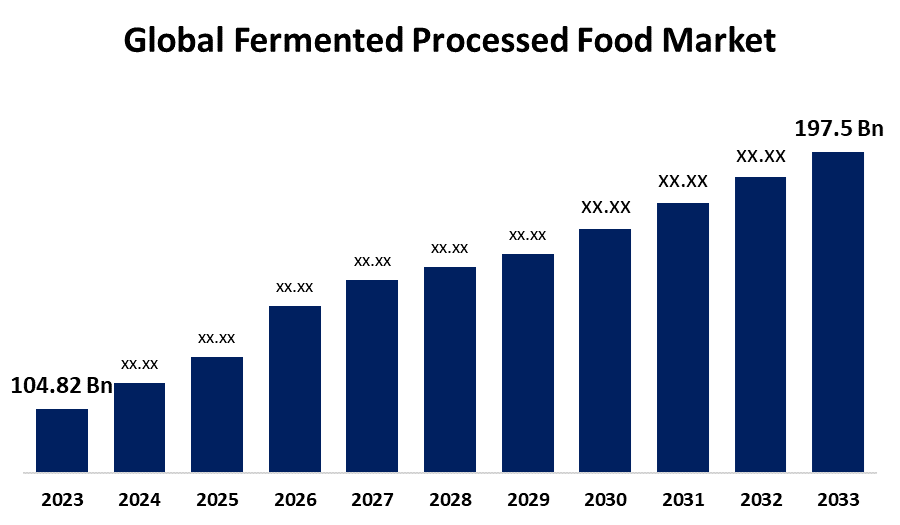Global Fermented Processed Food Market Size, Share, and COVID-19 Impact Analysis, By Product Type (Dairy Products, Bread and Bakery Products, Vegetables, Condiments, Beverages), By Microorganism Type (Bacteria, Yeast, Mold), By Distribution Channel (Supermarkets, Convenience Stores, Online Retail, Specialty Stores), and By Region (North America, Europe, Asia-Pacific, Latin America, Middle East, and Africa), Analysis and Forecast 2023 - 2033.
Industry: Food & BeveragesGlobal Fermented Processed Food Market Insights Forecasts to 2033
- The Global Fermented Processed Food Market Size was estimated at USD 104.82 Billion in 2023
- The Market Size is Expected to Grow at a CAGR of around 6.54% from 2023 to 2033
- The Worldwide Fermented Processed Food Market Size is Expected to Reach USD 197.5 Billion by 2033
- Asia Pacific is expected to grow the fastest during the forecast period.

Get more details on this report -
The global fermented processed food market size was worth around USD 104.82 billion in 2023 and is predicted to grow to around USD 197.5 billion by 2033 with a compound annual growth rate (CAGR) of roughly 6.54% between 2023 and 2033. The fermented processed food market is being driven by the growing health consciousness among consumers, an increase in demand for natural and functional foods, Innovations in fermentation technology, and Asia Pacific as an emerging key growth region.
Market Overview
The fermented processed food market is the sector of business producing, distributing, and consuming foodstuffs that include preparation through fermentation. Fermentation is a biological metabolic process whereby foodstuff ingredients, such as sugars or starches, are broken down into simpler molecules by microorganisms, bacteria, yeasts, or molds; thus, fermentation creates products that have highly improved flavors, textures, and nutritional value. Another associated benefit is the preservation of food, extended storage life, as well as additional health benefits offered by the possible presence of probiotics and some other bioactive compounds. Many fermented foods are also included in traditional diets in other cultures. Fermented foods continue to become trendy as global culinary trends evolve, and consumers grow more interested in discovering different cuisines internationally. Growing global consumer health consciousness is one of the main factors propelling the fermented processed food market. Fermented food is rich in probiotics; it helps in healthy gut support, promotes digestion, and enhances the immune system. With preventive healthcare gaining strong momentum, consumers are keen to find more natural and functional food products that will contribute to their well-being.
Report Coverage
This research report categorizes the fermented processed food market based on various segments and regions forecasts revenue growth and analyzes trends in each submarket. The report analyses the key growth drivers, opportunities, and challenges influencing the fermented processed food market. Recent market developments and competitive strategies such as expansion, type launch, development, partnership, merger, and acquisition have been included to draw the competitive landscape in the market. The report strategically identifies and profiles the key market players and analyses their core competencies in each sub-segment of the fermented processed food market.
Driving Factors
Fermented food is quite rich in probiotics; it helps in maintaining gut health, facilitating better digestion, and supporting the immune system. With the concept of preventive healthcare growing increasingly, consumers are very proactive about choosing natural and functional foods to add value to their well-being. Fermented processed foods have shelf-stable items that appeal particularly to the busy consumer, who requires convenient and long-lasting foodstuffs. Fermentation can extend the shelf life of food products without needing artificial preservatives. Advances in fermentation technologies have made it easy and efficient to produce a vast variety of fermented foods. With these developments, new products are produced with enhanced flavor, texture, and health benefits, further enhancing the attractiveness of the products to consumers.
Restraining Factors
Most of the consumers remain ignorant about the health benefits. Consumers know little or nothing about the function of probiotics, the fermentation process, and the contribution of these products to general well-being. This hinders the wide adoption of the products. Fermented foods commonly have strong acquired flavors that, in some respects, may be unappealing to consumers outside of regions and cultures where the foods are found. The sharpness or sourness of many of these foods discourages people used to other flavors.
Market Segmentation
The fermented processed food market share is classified into product type, microorganism type, and distribution channel
- The dairy products segment dominated the market in 2023 and is anticipated to grow at a significant CAGR during the forecast period.
Based on the product type, the fermented processed food market is divided into dairy products, bread and bakery products, vegetables, condiments, and beverages. Among these, the dairy products segment dominated the market in 2023 and is anticipated to grow at a significant CAGR during the forecast period. The growth is attributed to dairy products being rich in various nutrients, from calcium to proteins and vitamins B12 and more. Dairy products represent an ideal source of indispensable nutrients. Fermented dairy products contain high amounts of probiotics. These are beneficial bacteria that promote gut health and overall wellness in the gastrointestinal tract.
- The bacteria segment accounted for the majority share in 2023 and is anticipated to grow at a remarkable CAGR during the forecast period.
Based on the microorganism type, the fermented processed food market is divided into bacteria, yeast, and mold. Among these, the bacteria segment accounted for the majority share in 2023 and is anticipated to grow at a remarkable CAGR during the forecast period. The growth is driven by the primary benefits of beneficial bacteria, found in fermented foods and probiotics, including digestion, gut health, immune strength, and some possible mental benefits. Consumer interest is increasing awareness about products containing beneficial bacteria. There has been a renewed focus on gut health as further research continues to unveil the interrelation between gut microbiota and overall wellness.
- The supermarket segment accounted for the largest share in 2023 and is expected to grow at a substantial CAGR during the forecast period.
Based on the distribution channel, the fermented processed food market is divided into supermarkets, convenience stores, online retail, and specialty stores. Among these, the supermarkets segment accounted for the largest share in 2023 and is expected to grow at a substantial CAGR during the forecast period. The segmental growth is due to supermarkets creating a one-stop-shop convenience for most consumers, which makes it easier for them to come and buy along with other stuff that they purchase daily. Such consumers prefer coming to supermarkets with all their groceries in one supermarket, including food items like yogurts and cheeses, fermented pickles, as well as beverages like kefir or kombucha.
Regional Segment Analysis of the Fermented Processed Food Market
- North America (U.S., Canada, Mexico)
- Europe (Germany, France, U.K., Italy, Spain, Rest of Europe)
- Asia-Pacific (China, Japan, India, Rest of APAC)
- South America (Brazil and the Rest of South America)
- The Middle East and Africa (UAE, South Africa, Rest of MEA)
North America is anticipated to hold the biggest share of the fermented processed food market over the predicted timeframe.

Get more details on this report -
North America is anticipated to hold the biggest share of the fermented processed food market over the predicted timeframe. There is an increased consumer interest in functional foods, such as fermented products, which benefit the health system of consumers in North America, specifically in the United States and Canada. Popular products include yogurt, kefir, and kombucha, and more and more consumers are searching for these items to improve their well-being. North America is a region that largely has highly developed infrastructure for the production and distribution of food products, thus allowing easier access to the broad consumer base for the company’s manufacturing of fermented foods.
Asia Pacific is expected to grow at a rapid CAGR in the fermented processed food market during the forecast period. Fermented foods like kimchi, miso, sauerkraut, tempeh, and fermented rice products are staples in many countries of Asia Pacific region, which include China, Japan, South Korea, and India. The growing incomes, particularly in China and India, increasingly lead to more modernized diets, with an increase in the consumption of more processed foods. However, accompanying this trend is also growing consumer consciousness about the importance of healthier food choices, leading to an increasing demand for fermented foods.
Competitive Analysis:
The report offers the appropriate analysis of the key organizations/companies involved within the fermented processed food market along with a comparative evaluation primarily based on their type of offering, business overviews, geographic presence, enterprise strategies, segment market share, and SWOT analysis. The report also provides an elaborative analysis focusing on the current news and developments of the companies, which includes type development, innovations, joint ventures, partnerships, mergers & acquisitions, strategic alliances, and others. This allows for the evaluation of the overall competition within the market.
List of Key Companies
- Nestle
- Danone
- The Coca-Cola Company
- PepsiCo
- Anheuser-Busch InBev
- Heineken
- Mondelez International
- Kraft Heinz
- Unilever
- Fonterra Co-operative Group
- Others
Key Target Audience
- Market Players
- Investors
- End-users
- Government Authorities
- Consulting And Research Firm
- Venture capitalists
- Value-Added Resellers (VARs)
Recent Development
- In September 2022, Nestle Health Science's probiotics brand Garden of Life launched two new probiotics on China's offline retail market targeted at kids' growth and immune health. The latest products, solid beverages, will be sold as general foods. Garden of Life was introduced to China through a cross-border e-commerce channel in 2019.
Market Segment
This study forecasts revenue at global, regional, and country levels from 2023 to 2033. Spherical Insights has segmented the fermented processed food market based on the below-mentioned segments:
Global Fermented Processed Food Market, By Product Type
- Dairy Products
- Bread and Bakery Products
- Vegetables
- Condiments
- Beverages
Global Fermented Processed Food Market, By Microorganism Type
- Bacteria
- Yeast
- Mold
Global Fermented Processed Food Market, By Distribution Channel
- Supermarkets
- Convenience Stores
- Online Retail
- Specialty Stores
Global Fermented Processed Food Market, By Regional Analysis
- North America
- US
- Canada
- Mexico
- Europe
- Germany
- UK
- France
- Italy
- Spain
- Russia
- Rest of Europe
- Asia Pacific
- China
- Japan
- India
- South Korea
- Australia
- Rest of Asia Pacific
- South America
- Brazil
- Argentina
- Rest of South America
- Middle East & Africa
- UAE
- Saudi Arabia
- Qatar
- South Africa
- Rest of the Middle East & Africa
Need help to buy this report?